YouTube was officially founded on February 14th, 2005. The first video followed on April 23rd, with co-founder Jawed Karim publishing “Me at the zoo”. The now-legendary 18 seconds of the film have been viewed over 372 million times.
With over 2.54 billion active users, the platform has come a long way. In fact, 44.9% of all global internet users access YouTube regularly.
This article is a one-stop shop for a variety of YouTube demographic and usage statistics.
Here’s a summary of what you’ll learn:
YouTube Statistics (Top Picks)
- YouTube currently has 2.54 billion users. Up from 2 billion users in 2019.
- 44.9% of all global internet users access YouTube monthly.
- YouTube’s user count of 2.54 billion places it third on the list of most-used social media platforms. Only Facebook and WhatsApp have more users.
- India has the most YouTube users, estimated at 509 million. The United States follows, with 248 million.
- Globally, more men than women use YouTube.
- Quarterly YouTube ad revenue is nearly $10 billion.
- On average, individual creators receive between $1.61-$29.3 per 1000 views.
YouTube Active Users
According to the latest data, YouTube has 2.54 billion active users as of July 2025. Among these, there are more than 125 million paid subscribers, taking into account YouTube’s Premium and Music services.
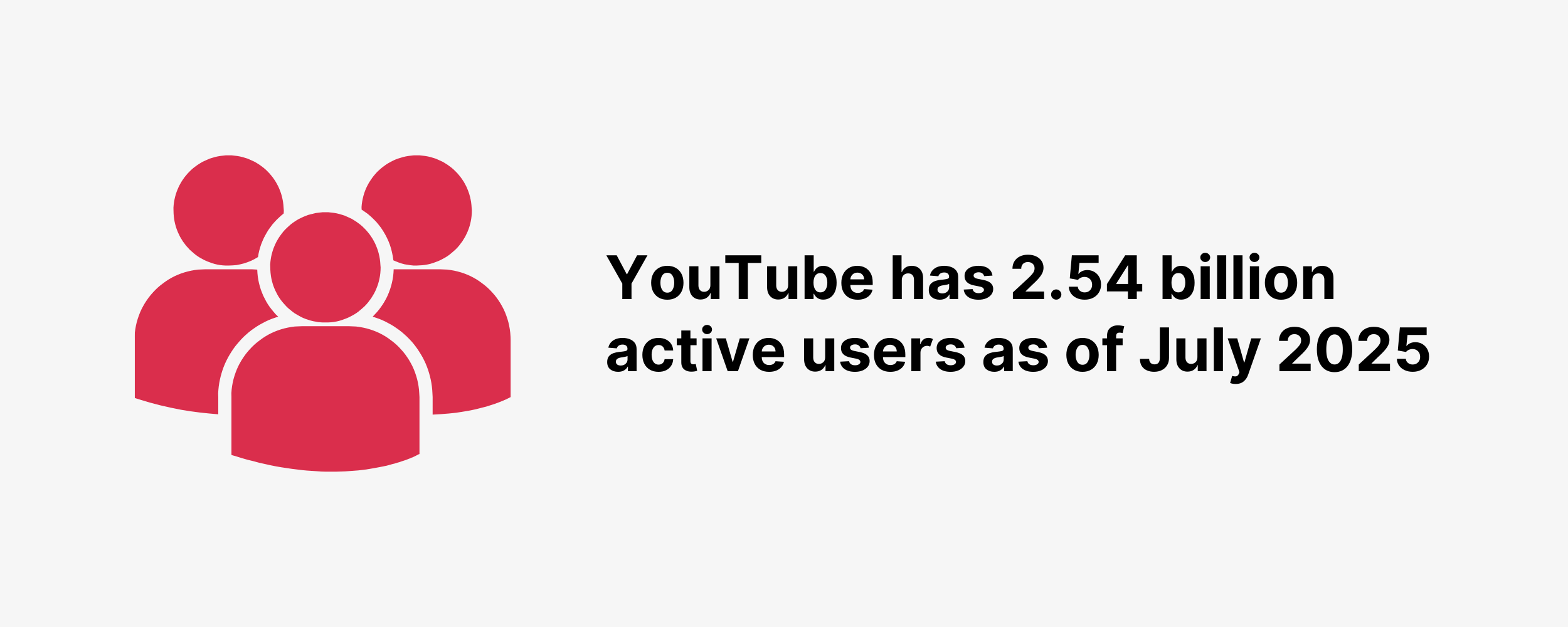
Nearly half (44.9%) of internet users worldwide access YouTube.
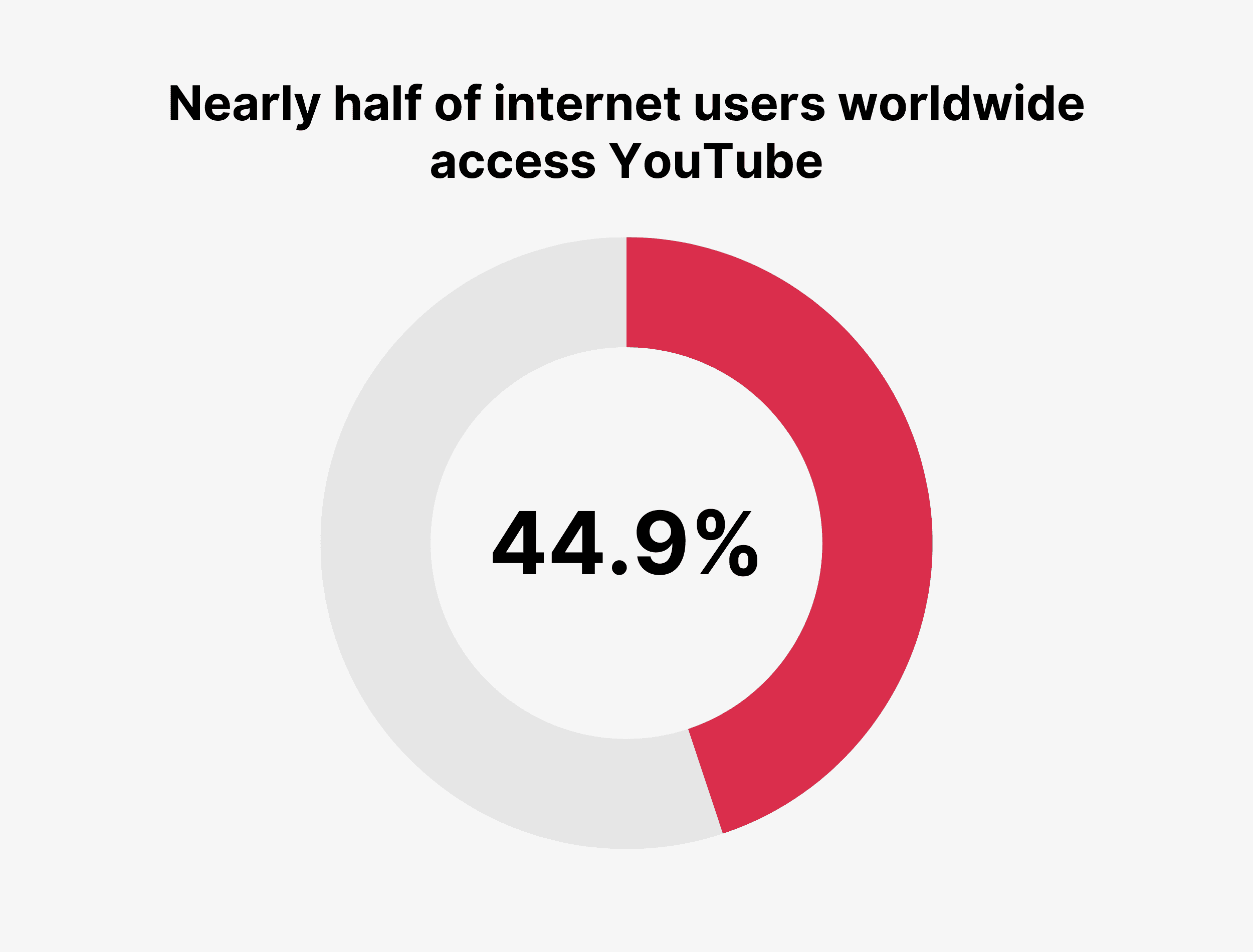
Source: DataReportal, YouTube
YouTube User Growth
YouTube currently has 2.49 billion users. Which means close to half of the global online population are YouTube users. So how did the video sharing platform get to this point?
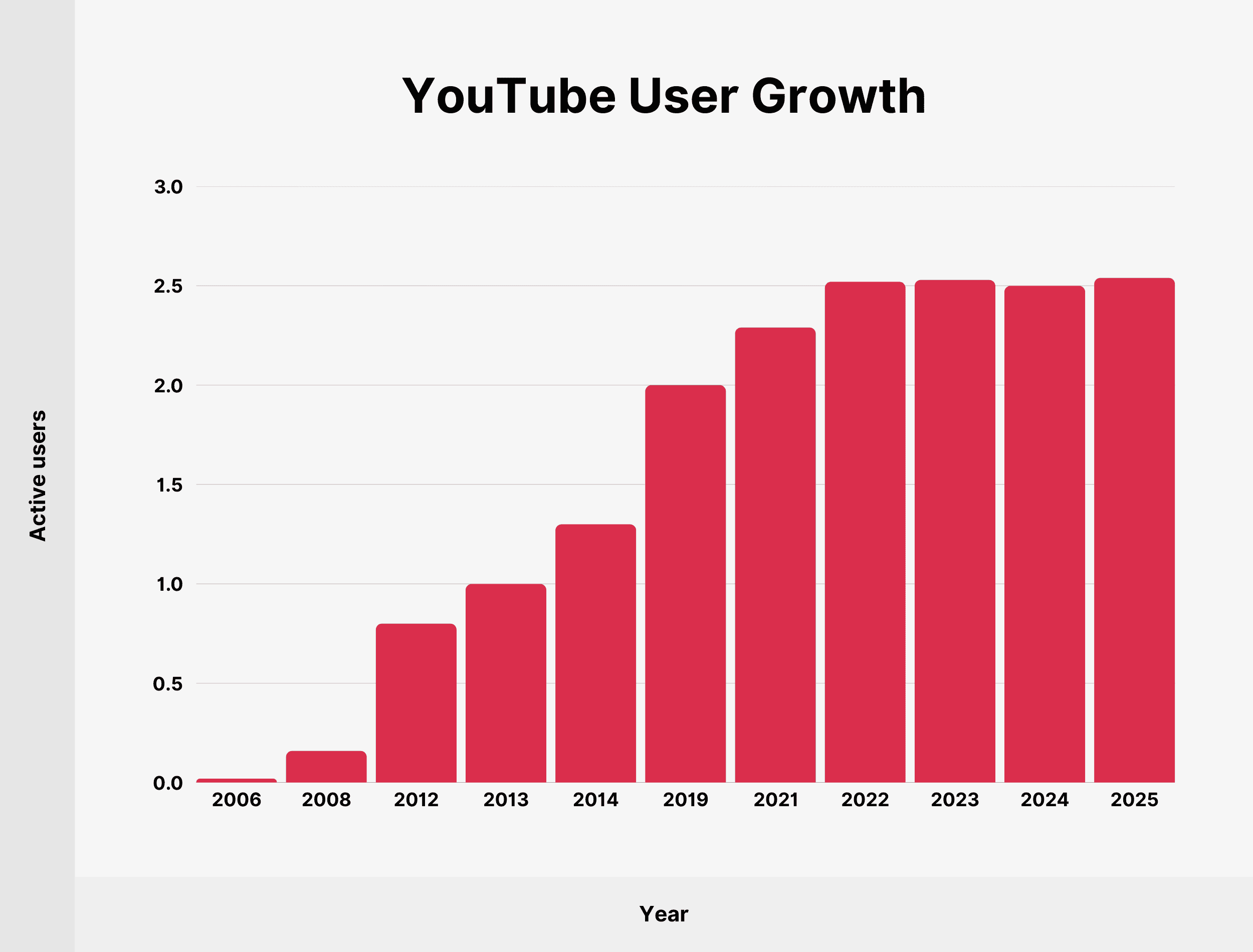
There isn’t any official consolidated data on YouTube’s user growth rate over time, but we can get a reasonable idea by pulling various sources together. Here are some milestones in terms of YouTube’s user growth.
| Year | Active users |
|---|---|
| 2006 | 20 million |
| 2008 | 160 million |
| 2012 | 800 million |
| 2013 | 1 billion |
| 2014 | 1.3 billion |
| 2019 | 2 billion |
| 2021 | 2.29 billion |
| 2022 | 2.52 billion |
| 2023 | 2.53 billion |
| 2024 | 2.5 billion |
| 2025 | 2.54 billion |
YouTube currently ranks as the 2nd most visited website worldwide. The only website to receive more traffic is that of its parent company, Google.
Sources: DataReportal, Semrush, The New York Times, The New Yorker, CNBC, The Mercury News, CNET
YouTube Users by Country
YouTube is localized in over 100 countries. It can also be used in 80 different languages. Clearly, the video sharing platform has become a truly global phenomenon. But how do usage statistics break down by country?
India has the largest YouTube audience. At least 509 million people living in India are YouTube users. The USA comes in second.
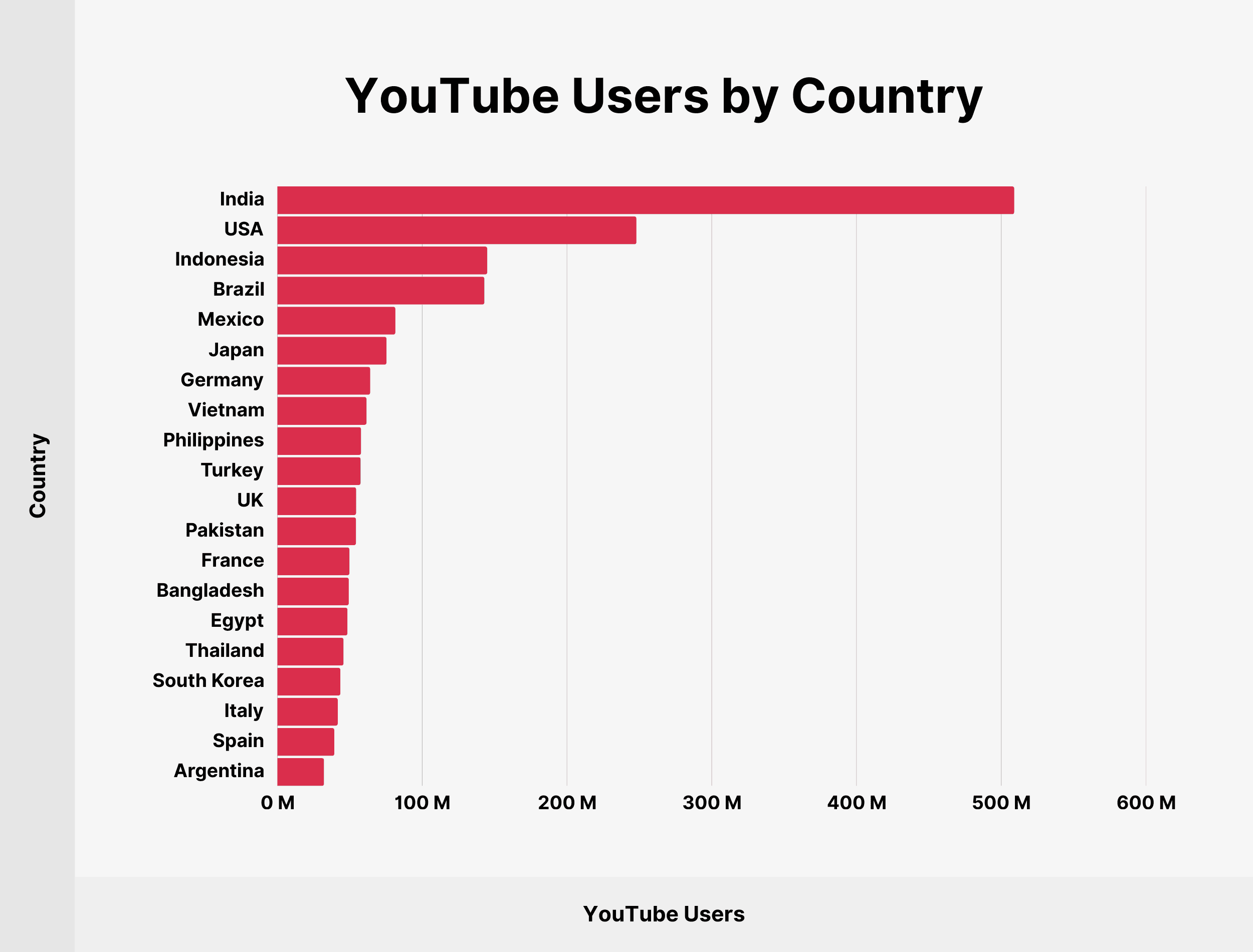
Here are the top ten countries by total estimated number of YouTube users:
| Country | YouTube Users |
|---|---|
| India | 509 million |
| USA | 248 million |
| Indonesia | 145 million |
| Brazil | 143 million |
| Mexico | 81.5 million |
| Japan | 75.4 million |
| Germany | 64.1 million |
| Vietnam | 61.6 million |
| Philippines | 57.8 million |
| Turkey | 57.5 million |
| UK | 54.4 million |
| Pakistan | 54.3 million |
| France | 49.8 million |
| Bangladesh | 49.3 million |
| Egypt | 48.4 million |
| Thailand | 45.7 million |
| South Korea | 43.5 million |
| Italy | 41.7 million |
| Spain | 39.3 million |
| Argentina | 32.2 million |
Sources: YouTube, DataReportal
Ranked 3rd: Most Used Social Media Platforms Worldwide
In 2025, YouTube is ranked third amongst all global social media platforms. Sorted by the number of active users, it is beaten only by Facebook and WhatsApp.
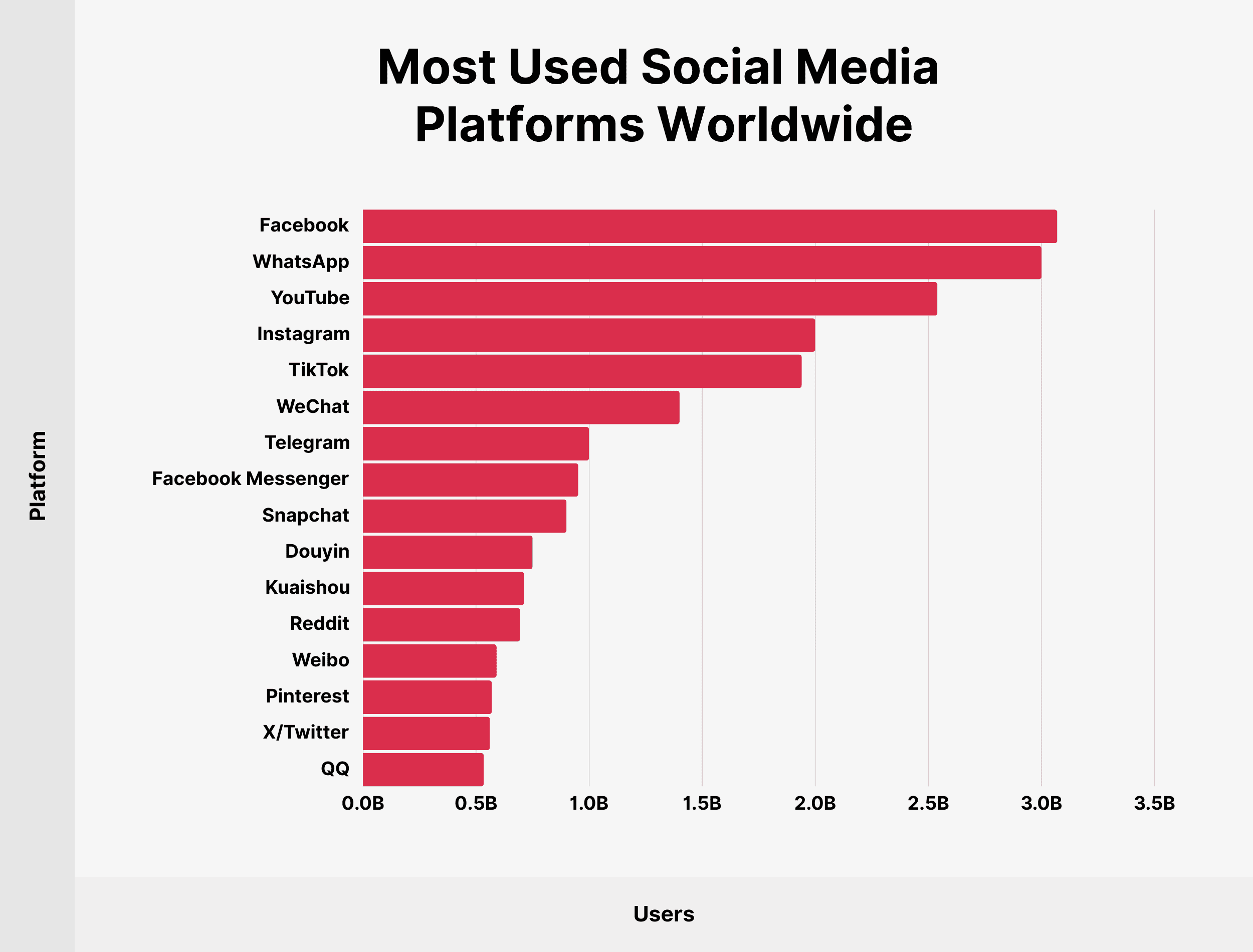
For context, there are just shy of 5.41 billion active social media users globally. So YouTube is one of just three platforms that can claim to have captured at least a 50% share of all social media users.
| Platform | Users |
|---|---|
| 3.07 billion | |
| 3 billion | |
| YouTube | 2.54 billion |
| 2 billion | |
| TikTok | 1.94 billion |
| 1.4 billion | |
| Telegram | 1 billion |
| Facebook Messenger | 952 million |
| Snapchat | 900 million |
| Douyin | 750 million |
| Kuaishou | 712 million |
| 695 million | |
| 591 million | |
| 570 million | |
| X/Twitter | 561 million |
| 534 million |
Source: DataReportal
YouTube User Demographics
Given that YouTube has 2.49 billion users, it can be safely said that people from a whole range of demographics use the site. But user breakdowns can give an idea of the groups of society where YouTube is the most popular.
YouTube Gender Demographics
50.2% of all adult YouTube users in the USA are female, while the remaining 49.8% are male. But globally, more male users use YouTube compared to female users, around 53.2% of YouTube users are male and 46.8% are female.
Any content creators without a specifically gendered target market should therefore be looking to make videos with a relatively even male/female viewer split in mind.
Source: DataReportal
YouTube Age Demographics
More than half (50.6%) of YouTube users are Gen Z and Millennials (born between 1981 and 2012). Only 15% of US YouTube are Baby boomers (1946-1964).

Here’s a detailed breakdown of US users by generation:
| Generation | Share of US YouTube users |
|---|---|
| Gen Z (1997-2012) | 25.1% |
| Millennials (1981-1996) | 25.5% |
| Gen X (1965-1980) | 19.9% |
| Baby Boomers (1946-1964) | 15.0% |
| Other | 14.5% |
Globally, around 56% of YouTube users are aged between 18 and 34 years old.
| Age group | Share of global YouTube users |
|---|---|
| 18-24 | 15.8% |
| 25-34 | 21.7% |
| 35-44 | 18.5% |
| 45-54 | 14% |
| 55-64 | 9.9% |
| 65+ | 9.5% |
Sources: eMarketer, DataReportal
YouTube Location Demographics
US adults living in suburban areas are more likely to use YouTube. 84% of those in suburbia are YouTube users, dropping to 85% in urban and 81% in rural locations.
Sorted by country, India has the most YouTube users. The USA follows, with Indonesia, Brazil, and Mexico next.
Sources: Pew Research Center, DataReportal
YouTube Income Demographics
In the USA, YouTube is most popular among high earners. 90% of those earning $100,000 or more say that they sometimes visit YouTube.
Among Americans with an income of $70,000-$99,999 income, 87% are Youtube users, and dropping to 79% among US adults with an income of between $30,000 and $69,999. That figure drops again for those earning under $30k, with 78% of this group using YouTube.
Source: Pew Research Center
YouTube User Education Level Data
These statistics reveal a correlation between YouTube usage in the USA and higher levels of education.
79% of adults with a high school education or less use the video-sharing platform. This rises to 87% for those with some college education. Among those with more than a college education, 90% use YouTube.
Source: Pew Research Center
YouTube Usage by Device
In YouTube’s early days, PCs and laptops were the only real viewing options. But the digital landscape has changed hugely since 2005. Smartphones and smart TVs have altered how people interact with the world – and with YouTube specifically.
The YouTube mobile app has over 10 billion downloads on the Google Play store. It is therefore unsurprising that 63% of all views on YouTube come from mobile devices.

To put it in a perspective, desktop computers accounted for only 12% of YouTube views.
Here’s a detailed of breakdown of global YouTube views by device in Q2 2021:
| Device | Share of YouTube video views |
|---|---|
| Mobile | 63% |
| Connected TV/other | 14% |
| Desktop | 12% |
| Tablet | 8% |
| Console | 3% |
According to another more recent report, mobile devices accounted for 69% of YouTube’s total viewership, with only 16% of views coming from TV in 2025 to date.
Sources: eMarketer, Google Play, Tubular Labs
Most-Subscribed YouTube Channels
MrBeast is the most-subscribed YouTube channel with 434 million subscribers to date.
Here is the top 10:
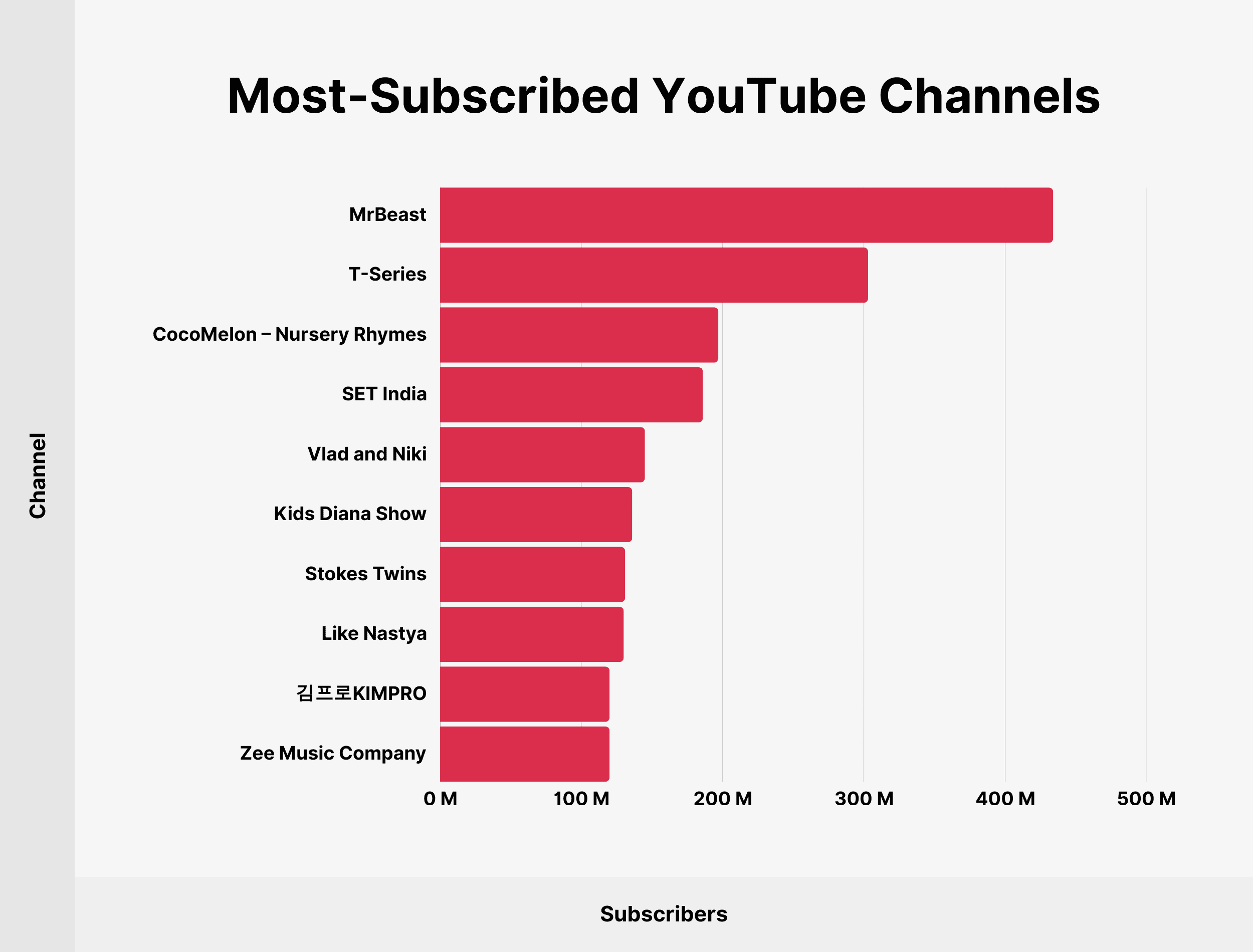
And here are the exact subscriber numbers:
| Channel | Subscribers |
|---|---|
| MrBeast | 434 million |
| T-Series | 303 million |
| CocoMelon – Nursery Rhymes | 197 million |
| SET India | 186 million |
| Vlad and Niki | 145 million |
| Kids Diana Show | 136 million |
| Stokes Twins | 131 million |
| Like Nastya | 130 million |
| 김프로KIMPRO | 120 million |
| Zee Music Company | 120 million |
Source: SocialBlade
Most-Viewed YouTube Videos
Baby Shark Dance is the most viewed YouTube video of all time, reaching over 15.47 billion hits.
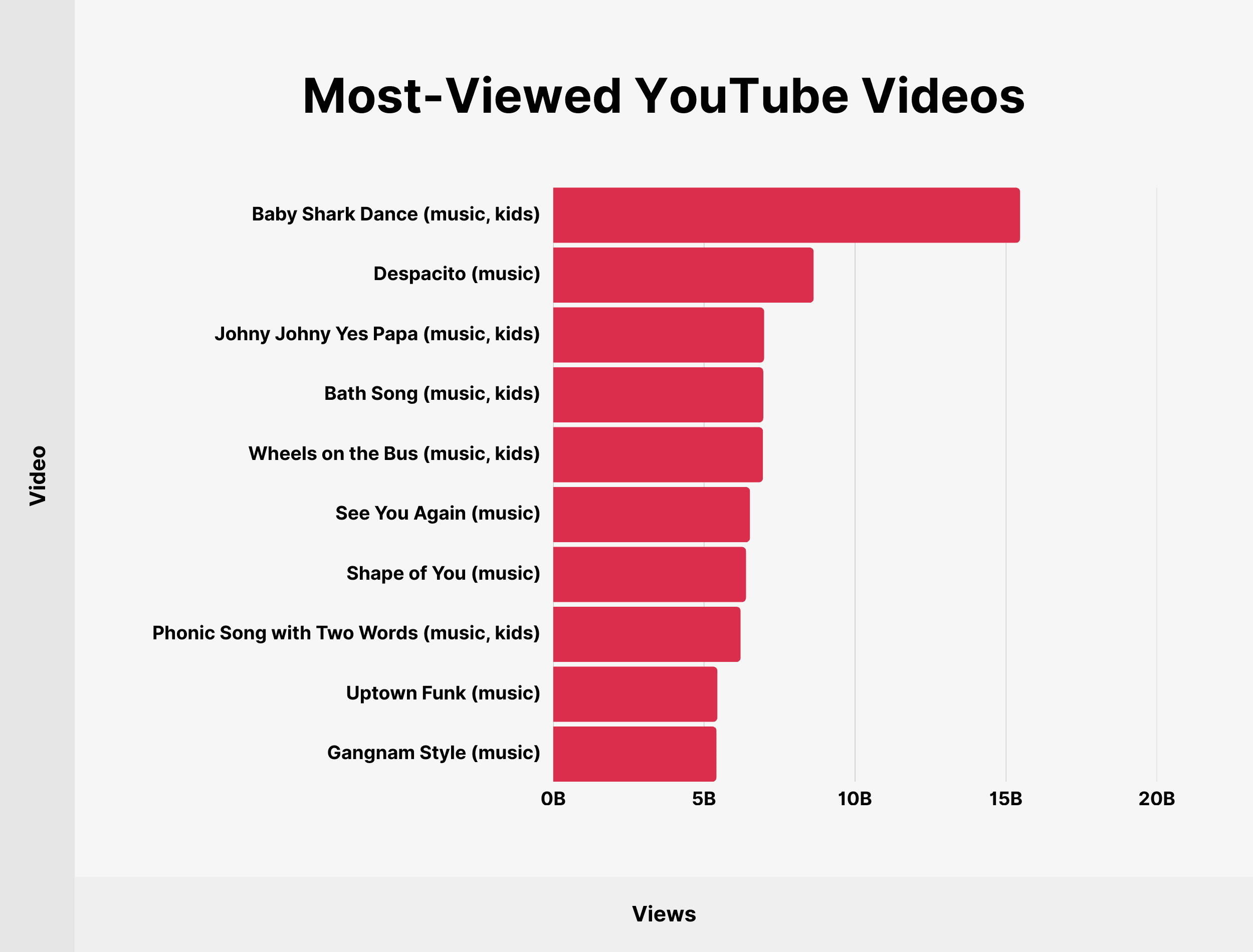
The top 10 is dominated by music. It looks like this:
| Video | Views |
|---|---|
| Baby Shark Dance (music, kids) | 15.47 billion |
| Despacito (music) | 8.63 billion |
| Johny Johny Yes Papa (music, kids) | 6.99 billion |
| Bath Song (music, kids) | 6.96 billion |
| Wheels on the Bus (music, kids) | 6.95 billion |
| See You Again (music) | 6.52 billion |
| Shape of You (music) | 6.39 billion |
| Phonic Song with Two Words (music, kids) | 6.21 billion |
| Uptown Funk (music) | 5.44 billion |
| Gangnam Style (music) | 5.41 billion |
Source: Statista
YouTube by the Money
In November 2006, Google purchased YouTube for $1.65 billion in stock. At the time, this was considered a hugely risky investment. Now, it earns nearly 5x this in ad revenue – quarterly.
YouTube advertising revenue amounted to $18.72 billion in the first six months of 2025, a 11.6% year-on-year increase.
YouTube’s ads accounted for a 10.03% share of Alphabet’s overall revenue in the first six months of 2025.
These figures don’t even include money from subscriptions. YouTube hit 125 million Music and Premium subscribers worldwide. A monthly individual subscription for YouTube Premium in the US costs $13.99.
Creators who are a part of the Partner Program on YouTube are paid 55% of advertising revenue, and YouTube takes a 45% cut. Actual earnings among YouTube creators vary significantly, depending on factors such as engagement rate, but as a rough average channel owners can earn between $1.61 and $29.30 for every 1000 video views.
Sources: Investopedia, Alphabet, YouTube, TechCrunch, Business Insider
Conclusion
You made it! That’s the end of my list of YouTube user statistics.
Hopefully, you found these facts and figures informative. Lots of the YouTube stats beyond their press page require some hunting down, but I’ve done my best to put a good selection together in one place.
Backlinko is owned by Semrush. We’re still obsessed with bringing you world-class SEO insights, backed by hands-on experience. Unless otherwise noted, this content was written by either an employee or paid contractor of Semrush Inc.
